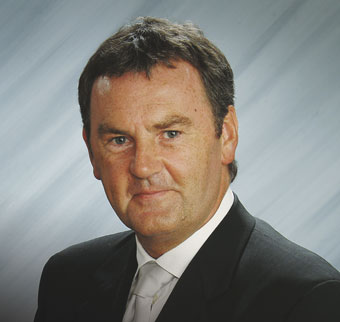Techniques for a passive fit
In the third part of his series of articles for Ireland’s Dental magazine, Dr Paul A. Tipton BDS, MSc, DGDP UK, looks at immediate replacement of hte failing full maxillary arch with a Peter Wörhle bridge
A common sight in many dental clinics is the patient who has a failing maxillary arch. This may well be due to inappropriate restorations over the years, periodontal disease or caries, or a combination of each. The standard solution is to remove all the teeth in the maxillary arch and replace with either a full upper denture, overdenture supported by implants or an implant-supported bridge.
The problem sometimes comes when the patient refuses to have an interim denture made and will not be edentulous for a period of time. There is then the need for an immediate loading protocol.
Immediate loading
Tanow (1997) was one of the first to describe the success rates with immediate loaded implants in a series of 10 consecutive case reports. Schnitman, in the same year, completed a similar study on Nobel Biocare implants. Each had similar results of between 90-95 per cent success for implants, irrespective of whether they were immediately loaded or submerged, and 100 per cent success for the bridgework in these small samples.
Since then, many more studies have shown similar success rates for both submerged implants and immediately loaded implants.
Case presentation
Mr G presented with failing upper and lower dentitions and was planned initially for immediate extraction, implant placement and immediate loading of the lower jaw, followed two weeks later by the same treatment protocol in the upper jaw.
After a period of approximately six months for osseointegration, the patient was planned for a Peter Wörhle-style bridge in the upper and a traditional porcelain fused to metal (PFM) bridge in the lower jaw.
Peter Wörhle bridge
This bridge is also known by its longer name, the ‘pink porcelain fused to metal framework with cemented individual crowns permanently cemented onto metal copings temporarily cemented onto custom made abutments’.
The bridge evolved from the problems that clinicians have always had with the fit of full arch restorations, the maintenance of such restorations and the aesthetics. The holy grail of full arch bridgework on implants is to find a technique that gives a passive fit. This technique delivers such a solution.
Technique
Preliminary impressions were taken of the implants in the upper jaw using traditional implant pick up impression copings. A maxillary model was poured and custom-made abutments fabricated. At this stage there would always be inaccuracies between model and mouth due to the inherent inaccuracies in all impression techniques.
Metal copings were waxed and cast onto the custom-made abutments and were used in place of the traditional Duralay pick up copings, in the ‘Duralay pick-up copings technique’. This impression technique is used for the secondary, more accurate impressions and the technique involves coat hanger wire duralayed using the ‘bead on technique’ onto the metal custom made pick-up copings. The custom-made abutments were then replaced into the metal copings in the pick-up impression and a new master model is poured which was considerably more accurate.
The custom-made abutments were re-milled to a two to six degree convergence angle (fig 1) and the copings trimmed and adjusted so as to fit accurately around the margins of the custom made abutments (fig 2).
The technician then waxed and cast the metal framework for the bridge, which is then covered by pink porcelain and fitted onto the copings, fitting accurately onto the abutments (fig 3). Individual PFM crowns were then fabricated onto the metal tooth preparations on the bridge framework and cemented in place, using GIC (figs 4 and 5).
The custom-made abutments were then fitted into the mouth and torqued down onto the implants to 32 Ncm; the copings placed onto the abutments and the bridge cemented over the top of the copings using Panavia.
The margins were covered with Oxyguard and, once set, the bridge on the copings was removed, cleaned and polished (figs 6 and 7) and then
cemented permanently onto custom-made abutments using a temporary cement (temp bond) for retrieveability (figs 8-10).
Conclusions
This style of bridge gives both the patient and clinician retrieveability and passive fit; as well as maintenance potential – if a part of the bridge (crown) fractures, it is removed, an impression taken of the metal tooth prep underneath and a new crown fabricated and cemented.
Finally, it has the potential for exceptional aesthetics.
ABOUT THE AUTHOR
A highly respected specialist prosthodontist, Dr Paul Tipton has published many scientific articles in the dental press and is an expert lecturer in his field with Tipton Training Academies in Dublin, Manchester, Leeds and London. After gaining his masters degree in conservative dentistry in 1989, he was awarded the diploma in general dental practice by the Royal College of Surgeons four years later and received specialist status in prosthodontics in 1999 from the GDC.
An ex-professional cricketer with Lancashire County Cricket Club, he is a past-president of the British Academy of Implant Dentistry (http://www.baid.org.uk). He is one of the UK’s most successful dental teachers in the fields of restorative, cosmetic and implant dentistry over the last 20 years with more than 2,000 dentists completing a year-long certificate courses from one of the Tipton Training Academies (http://www.tiptontraining.co.uk”>www.tiptontraining.co.uk). The next implant course starts in Manchester in February 2011.
For medical images please see printed magazine, or click here to visit our interactive online version
®
Dr Tipton thanks the following for contributing to this series:
• Dr Ibrahim Hussain, BDS, M Med Sci Implantology – implant surgeon
• Dr Andrew Watson, BDS, MSc, specialist in endodontics
• Mr John Wibberley, dental technician, Waters Edge Laboratory, Lancashire
• Dr Amit Patel, BDS, MSc, MClinDent, MFDS, RCSEd , MRD, RCSEng specialist in periodontics.

